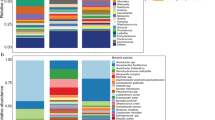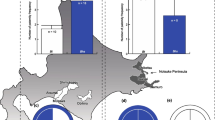Abstract
Many bumblebee species have been suffering from significant declines across their ranges in the Northern Hemisphere over the last few decades. The remaining populations of the rare species are now often isolated due to habitat fragmentation and have reduced levels of genetic diversity. The persistence of these populations may be threatened by inbreeding depression, which may result in a higher susceptibility to parasites. Here we investigate the relationship between genetic diversity and prevalence of the parasitic mite Locustacarus buchneri in bumblebees, using the previously-studied system of Bombus muscorum and Bombus jonellus in the Western Isles of Scotland. We recorded L. buchneri prevalence in 17 populations of B. muscorum and 13 populations of B. jonellus and related the results to levels of heterozygosity. For B. muscorum, we found that prevalence of the mite was higher in populations with lower genetic diversity but there was no such relationship in the more genetically diverse B. jonellus. In contrast to population-level measures of genetic diversity, the heterozygosity of individual bees was not correlated with infection status. We suggest population-level genetic homogeneity may facilitate parasite transmission and elevate prevalence, with potential consequences for population persistence.

Similar content being viewed by others
References
Baer B, Schmid-Hempel P (2001) Unexpected consequences of polyandry for parasitism and fitness in the bumblebee, Bombus terrestris. Evolution 55:1639–1643
Bashir-Tanoli S, Tinsley MC (2014) Immune response costs are associated with changes in resource acquisition and not resource reallocation. Funct Ecol. doi:10.1111/1365-2435.12236
Bates D, Maechler M, Bolker B, Walker S (2013) lme4: linear mixed-effects models using Eigen and S4. R package version 1.0-4. http://CRAN.R-project.org/package=lme4
Benton T (2006) Bumblebees. HarperCollins Publishing, London
Brown MJF, Moret Y, Schmid-Hempel P (2003) Activation of host constitutive immune defence by an intestinal trypanosome parasite of bumble bees. Parasitology 126:253–260
Cameron SA, Lozier JD, Strange JP, Koch JB, Cordes N, Solter LF, Griswold TL (2011) Patterns of widespread decline in North American bumble bees. Proc Natl Acad Sci-Biol 108:662–667
Coltman DW, Pilkington JG, Smith JA, Pemberton JM (1999) Parasite-mediated selection against inbred Soay sheep in a free-living, island population. Evolution 53:1259–1267
Darvill B, Ellis JS, Lye GC, Goulson D (2006) Population structure and inbreeding in a rare and declining bumblebee, Bombus muscorum (Hymenoptera: Apidae). Mol Ecol 15:601–611
Darvill B, O’Connor S, Lye GC, Waters J, Lepais O, Goulson D (2010) Cryptic differences in dispersal lead to differential sensitivity to habitat fragmentation in two bumblebee species. Mol Ecol 19:53–63
de Castro F, Bolker B (2005) Mechanisms of disease-induced extinction. Ecol Lett 8:117–126
Ebert D, Altermatt F, Lass S (2007) A short term benefit for outcrossing in a Daphnia metapopulation in relation to parasitism. J R Soc Interface 4:777–785
Ellis JS, Knight ME, Darvill B, Goulson D (2006) Extremely low effective population sizes, genetic structuring and reduced genetic diversity in a threatened bumblebee species, Bombus sylvarum (Hymenoptera: Apidae). Mol Ecol 15:4375–4386
Field SG, Lange M, Schulenburg H, Velavan TP, Michiels NK (2007) Genetic diversity and parasite defense in a fragmented urban metapopulation of earthworms. Anim Conserv 10:162–175
Frankham R, Ballou JD, Briscoe DA (2010) Introduction to conservation genetics. Cambridge University Press, Cambridge
Goodnight KF, Queller DC (1999) Computer software for performing likelihood tests of pedigree relationship using genetic markers. Mol Ecol 8:1231–1234
Goulson D (2010) Bumblebees; their behaviour, ecology and conservation. Oxford University Press, Oxford
Goulson D, Lye GC, Darvill B (2008) Decline and conservation of bumblebees. Annu Rev Entomol 53:191–208
Harrison JF, Camazine S, Marden JH, Kirkton SD, Rozo A, Yang XL (2001) Mite not make it home: tracheal mites reduce the safety margin for oxygen delivery of flying honeybees. J Exp Biol 204:805–814
Hedrick PW, Kim TJ, Parker KM (2001) Parasite resistance and genetic variation in the endangered Gila topminnow. Anim Conserv 4:103–109
Hughes WHO, Boomsma JJ (2004) Genetic diversity and disease resistance in leaf-cutting ant societies. Evolution 58:1251–1260
Husband RW, Sinha RN (1970) A revision of Genus Locustacarus with a key to genera of family Podapolipidae (Acarina). Ann Entomol Soc Am 63:1152
Kaunisto KM, Viitaniemi HM, Leder EH, Suhonen J (2013) Association between host’s genetic diversity and parasite burden in damselflies. J Evol Biol 26:1784–1789
Korner P, Schmid-Hempel P (2005) Correlates of parasite load in bumblebees in an Alpine habitat. Entomol Sci 8:151–160
Lozier JD, Strange JP, Stewart IJ, Cameron SA (2011) Patterns of range-wide genetic variation in six North American bumble bee (Apidae: Bombus) species. Mol Ecol 20:4870–4888
Luong LT, Heath BD, Polak M (2007) Host inbreeding increases susceptibility to ectoparasitism. J Evol Biol 20:79–86
Marshall TC, Coltman DW, Pemberton JM, Slate J, Spalton JA, Guinness FE, Smith JA, Pilkington JG, Clutton-Brock TH (2002) Estimating the prevalence of inbreeding from incomplete pedigrees. Proc R Soc Lond B Bio 269:1533–1539
McMullan JB, Brown MJF (2009) A qualitative model of mortality in honey bee (Apis mellifera) colonies infested with tracheal mites (Acarapis woodi). Exp App Acarol 47:225–234
Moret Y, Schmid-Hempel P (2001) Entomology—immune defence in bumble-bee offspring. Nature 414:506
Moret Y, Schmid-Hempel P (2004) Social life-history response to individual immune challenge of workers of Bombus terrestris L.: a possible new cooperative phenomenon. Ecol Lett 7:146–152
Mueller UG, Wolfmueller B (1993) A method for estimating the age of bees—age-dependent wing wear and coloration in the Wool-Carder Bee Anthidium manicatum (Hymenoptera, Megachilidae). J Insect Behav 6:529–537
Pemberton J (2004) Measuring inbreeding depression in the wild: the old ways are the best. Trends Ecol Evol 19:613–615
R Core Team (2013) R: a language and environment for statistical computing. R Foundation for Statistical Computing, Vienna, Austria. ISBN 3-900051-07-0. http://www.R-project.org/
Raymond M, Rousset F (1995) GENEPOP (version 1.2)—population genetics software for exact tests and ecumenicism. J Heredity 86:248–249
Reed DH, Nicholas AC, Stratton GE (2007) Genetic quality of individuals impacts population dynamics. Anim Conserv 10:275–283
Saccheri I, Kuussaari M, Kankare M, Vikman P, Fortelius W, Hanski I (1998) Inbreeding and extinction in a butterfly metapopulation. Nature 392:491–494
Seeley TD, Tarpy DR (2007) Queen promiscuity lowers disease within honeybee colonies. Proc R Soc Lond B Bio 274:67–72
Shykoff JA, Schmid-Hempel P (1991) Incidence and effects of 4 parasites in natural-populations of bumble bees in Switzerland. Apidologie 22:117–125
Slate J, Pemberton J (2002) Comparing molecular measures for detecting inbreeding depression. J Evol Biol 15:20–31
Slate J, Kruuk LEB, Marshall TC, Pemberton JM, Clutton-Brock TH (2000) Inbreeding depression influences lifetime breeding success in a wild population of red deer (Cervus elaphus). Proc R Soc Lond B Bio 267:1657–1662
Slate J, David P, Dodds KG, Veenvliet BA, Glass BC, Broad TE, McEwan JC (2004) Understanding the relationship between the inbreeding coefficient and multilocus heterozygosity: theoretical expectations and empirical data. Heredity 93:255–265
Spielman D, Brook BW, Briscoe DA, Frankham R (2004) Does inbreeding and loss of genetic diversity decrease disease resistance? Conserv Genet 5: 439–448
Trouve S, Degen L, Renaud F, Goudet J (2003) Evolutionary implications of a high selfing rate in the freshwater snail Lymnaea truncatula. Evol 57:2303–2314
Whitehorn PR, Tinsley MC, Brown MJF, Darvill B, Goulson D (2011) Genetic diversity, parasite prevalence and immunity in wild bumblebees. Proc R Soc Lond B Bio 278:1195–1202
Williams PH (1986) Environmental change and the distribution of British bumble bees. Bee World 67:50–61
Williams PH, Osborne JL (2009) Bumblebee vulnerability and conservation world-wide. Apidologie 40:367–387
Acknowledgments
We thank an anonymous reviewer for comments on the manuscript. PRW was funded by a National Environment Research Council studentship.
Author information
Authors and Affiliations
Corresponding author
Rights and permissions
About this article
Cite this article
Whitehorn, P.R., Tinsley, M.C., Brown, M.J.F. et al. Genetic diversity and parasite prevalence in two species of bumblebee. J Insect Conserv 18, 667–673 (2014). https://doi.org/10.1007/s10841-014-9673-1
Received:
Accepted:
Published:
Issue Date:
DOI: https://doi.org/10.1007/s10841-014-9673-1




